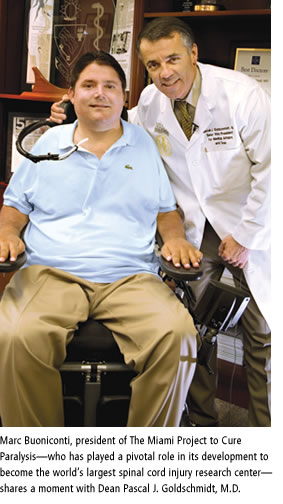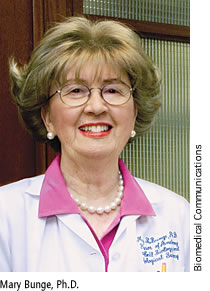 On this 26th of October the Spanish moss was dribbling down the branches of the oak trees of Charleston, South Carolina, like the hair of the Goddess Clotho as she was contemplating a thread of life to be severed. The air was still; even the winds were holding their breath as the fate of young Marc Buoniconti was unfolding on radio and television airwaves across the world. That day in 1985 little was known about the spinal cord injury that befell Marc on the football field, and even less was known about ways to protect the delicate nerve fibers that connect the human brain to each organ and limb of the body. On this 26th of October the Spanish moss was dribbling down the branches of the oak trees of Charleston, South Carolina, like the hair of the Goddess Clotho as she was contemplating a thread of life to be severed. The air was still; even the winds were holding their breath as the fate of young Marc Buoniconti was unfolding on radio and television airwaves across the world. That day in 1985 little was known about the spinal cord injury that befell Marc on the football field, and even less was known about ways to protect the delicate nerve fibers that connect the human brain to each organ and limb of the body.
It was clear to Marc Buoniconti that day that it was the end of what he calls his “first life” and the beginning of his “second life.” His father, Hall of Fame football player and Fortune 500 company businessman Nick Buoniconti, had raised his third child to become a football player, a good-looking guy whose primary concern was all about being physical. Unbeknownst to Marc and his family, that fateful day his dreams would be shattered and the body that carried him so daringly would suddenly cease to respond to his commands.
Marc’s “second life” started with the wails of ambulance sirens and the glare of operating room lights. The situation was grave, but his family—mother Terry, father Nick, sister Gina, and brother Nick Jr.—gave him the force to survive. They brought in neurosurgeon Barth Green, who gave Marc a chance to pull through. Destiny, apparently, did not know that “you just don’t mess with the Buonicontis.” This is not a family that accepts tragedy as an outcome; it is a family that can turn the toughest game around, can take any defeat and turn it into a victory. But the challenge of spinal cord injury and paralysis, “quadriplegia” as we call it in our doctors’ jargon, was the greatest challenge that ever knocked on the Buonicontis’ door.
With his parents by his side and with the help of Dr. Green and his team at the University of Miami School of Medicine, Marc survived. The encounter between Barth Green, the neurosurgeon who had seen enough kids and adults become paralyzed for life, and Nick Buoniconti, the entrepreneur who once and for all decided he would never take “no” for an answer, was historic and would change the future of patients with spinal cord injury and consequent paralysis. With giant steps, the Buoniconti Fund was created to serve as the economic engine to propel The Miami Project to Cure Paralysis into the sphere of elite research programs in the country. It was a gutsy move and few scientists took it seriously.
 That is when Dick and Mary Bunge joined The Project. World-renowned neuroscientists, they came to Miami to accomplish their dream: to use Schwann cells to cure paralysis. They succeeded in doing so in rats, restoring lower-limb function after severing their spinal cords, using an improved Schwann cell therapeutic approach. Then W. Dalton Dietrich took the lead of The Project to advance this fabulous success story to treat human paralysis. That is when Dick and Mary Bunge joined The Project. World-renowned neuroscientists, they came to Miami to accomplish their dream: to use Schwann cells to cure paralysis. They succeeded in doing so in rats, restoring lower-limb function after severing their spinal cords, using an improved Schwann cell therapeutic approach. Then W. Dalton Dietrich took the lead of The Project to advance this fabulous success story to treat human paralysis.
Today we are starting clinical trials on real patients with paralysis. From hypothermia techniques to acutely reduce spinal cord damage following injury to recovery of spinal cord function in individuals with established cord damage, we are moving our science—and the science developed by investigators from around the world—to the bedside to allow patients with paralysis to recover and once again stand up.
It has been 23 years since Marc was injured, and he is ready for his “third life.” Frankly, I have never encountered an individual I admire more than Marc Buoniconti. His steadfast courage has been the engine behind The Miami Project and the fuel of our inspiration. No one deserves more to heal and once again stand up on the legs that he has so often watched and wondered, “Why can’t you do what I ask you to do?” Marc will succeed, because he is a natural-born winner, because he is a Buoniconti, and because he was born to stand!
To learn more about The Miami Project to Cure Paralysis and its extraordinary multidisciplinary research endeavors, visit www.miamiproject.miami.edu. |


